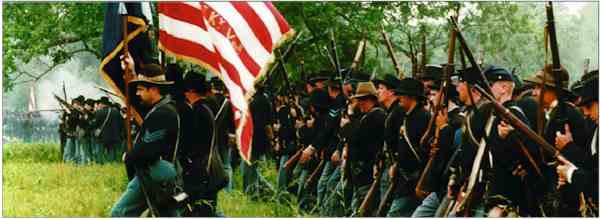 |
|
The
Reenactment of the Battle of Raymond, the Battle of Jackson, and the
battle of Champion Hill proved to be one of the most brilliant
series of events ever held in the Town of Raymond. More than ever,
spectators reflected a great sense of pride regarding the role
Raymond played during the Civil War years and the famous Vicksburg
Campaign. |
 |
|
The
Battle of Jackson, held at Waverly Plantation with more than 3,500
reenactors, was one of the many weekend events |
CROWDS OF SPECTATORS watched in awe as Confederate and Union
soldiers reenacted the sights and sounds of three major battles held
during the Vicksburg Campaign: The Battle of Raymond, the Battle of
Jackson and the Battle of Champion Hill, "I was so moved during
the Battle of Raymond," confessed a spectator from Oklahoma,
" that tears came to my eyes."
THE
REENACTMENT
was the largest event of its kind to be held in Mississippi and among
the largest held in the nation. Over 3,500 reenactors from a
cross-section of America participated in the "living history"
event. Full-scale Civil War cannons and hundreds of Calvary troopers
added to the excitement of each battle. For the first time in 135 years,
the town of Raymond heard the sound of cannons and gunfire exploding
from a distance.
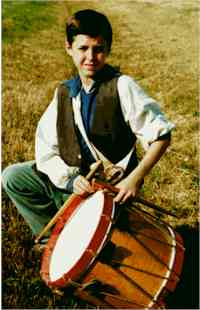 |
|
Cooper
McCracken, Drummer Boy from Memphis. |
CIVIL
WAR REENACTMENTS, also known as Living History, has rapidly become one of
the fastest growing hobbies in the United States. For many it could even
be considered a family kind of thing. Linda Shott from Plainview,
Arkansas, commented, "My family and I try to participate in at
least one reenactment every month. My husband and son are in blue just
as often as they are in gray." When joining a Civil War
reenactment organization, men have a variety of units to choose from;
Heavy Artillery, the Infantry, the Calvary, Mounted Rifles, Medical
Department and others. Boys 15 and younger often sign with the Fife,
Drum and Bugle Corps. Women and children are also encouraged to
participate in a variety of interesting roles.
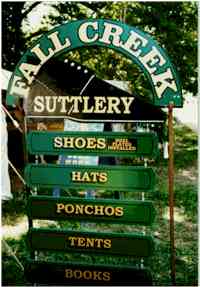 PERIOD
COSTUMES ARE EXPENSIVE. The average cost of outfitting a
Confederate or Union soldier is approximately $400-$500 dollars. The
women also pay a fortune for dresses, corsets, hoops and jewelry. To
meet the need for "supply and demand," new type of business
known as the suttlery has surfaced. In Civil War times, a 'sutler' was a
person who followed the army and sold items such as whiskey, trinkets
and medicine to the soldiers. Today, a large number of suttlery
companies supply the customer with historical reproductions of Civil War
items: clothing, tents, muskets, buckles, shoes, boots, eye glasses,
swords, guns etc. Many of the items can be ordered from companies who
advertise on the Internet.
PERIOD
COSTUMES ARE EXPENSIVE. The average cost of outfitting a
Confederate or Union soldier is approximately $400-$500 dollars. The
women also pay a fortune for dresses, corsets, hoops and jewelry. To
meet the need for "supply and demand," new type of business
known as the suttlery has surfaced. In Civil War times, a 'sutler' was a
person who followed the army and sold items such as whiskey, trinkets
and medicine to the soldiers. Today, a large number of suttlery
companies supply the customer with historical reproductions of Civil War
items: clothing, tents, muskets, buckles, shoes, boots, eye glasses,
swords, guns etc. Many of the items can be ordered from companies who
advertise on the Internet.
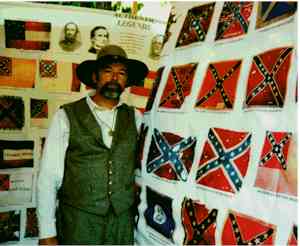 |
|
Terry
Stuckey from Pascagoula, Mississippi, and his authentic flag
reproductions. |
FLAGS
WITH STARS AND STRIPES were important to Confederate and Union Armies. Flags
varied as to each regiment and each state. Of interest to Civil War
buffs whose ancestors fought in the War was a novelty shop owned by
Terry Stuckey from Pascagoula. The shop, Authentic Legends, was
located near the main gate leading into Waverly. Stuckey delighted the
crowds with his display of "Stars and Strips" decals - each
representing a different state and a different brigade. One of the most
popular selling shirts with the flag emblem was the Bonnie Blue Flag
of Mississippi.
SOLDIERS
IN THE CALVARY
pay a high price to be a reenactor. All horses on the battlefield have
to be attired with appropriate equipment. In addition to the expense of
saddles, saddle bags, blankets, and bridles, the owner also has to keep
the horse shod as well as owning a large truck and trailer for hauling.
 |
|
Brad
West from Eudora, Kansas, and his horse, "Minty", served
as Courier for the Federal Commanders. |
Calvary reenactors often
drive their horses all across the United States to be a part a
particular reenactment. For a member of the Calvary, this all spells
'big bucks.' But, no one is complaining. They love the action and they
love their horses .
Brad West,
Gary Nichols and Steve Grice are Civil War reenactors who serve in the
Calvary Unit. Gary and Steve from Panama City, Florida, arrived in
Raymond just in time to unload their horses and saddle up for the
action. "During today's battle I'll be riding Courier for the
Commander of the Confederate Forces and delivering messages,"
stated Nichols. We are both members of the 1st Alabama Calvary CSA.
Grice was also excited about the battle. As he 'saddled up' he
commented, "In 1862, my ancestor fought with the 26th
Mississippi in the Infantry at the Battle of Champion Hill. So, for me,
this is a very special event to be involved in." Brad, from
Eudora, Kansas served as Courier for the Federal Commanders.
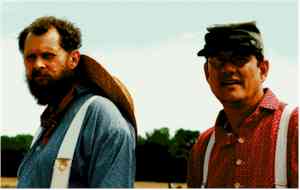 |
|
Royce
Loesch and Kirk Hale, members of the Landis Confederate Battery,
Light Artillery Unit, St. Joseph, Missouri, traveled to Raymond
from South Dakota and Kansas City. |
ROYCE
LOESCH and KIRK HALE, members of the Landis Confederate Battery, Light
Artillery Unity were also preparing for the Battle of Raymond. "I'm
from South Dakota," stated Loesch, "and Kirk is from
Kansas City. We are both members of the Landis Confederate Battery which
is out of St. Joseph, Missouri." Loesch added, "This is
my first time to Raymond but we've all heard about the Battle of Raymond
and the Battle of Champion Hill. I was really happy to get down this way
because my great-great uncle was captured in Canton during the war. He
was taken to a prison in Andersonville and stayed there for a year
before being released. He lived to be 101 years old."
 |
|
A
Military Parade in front of the historic Raymond Courthouse
featured more than 3,500 Confederate and Union reenactors. |
THE REENACTMENT of the Battle of Raymond, the Battle of Jackson and the
Battle of Champion Hill proved to be one of the most brilliant series of
events ever held in the Town of Raymond. More than ever, spectators
reflected a great sense of pride regarding the role Raymond played
during the Civil War years and the famous Vicksburg Campaign.
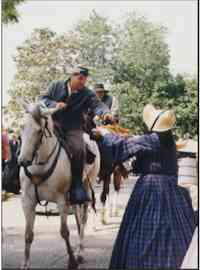 THREE THOUSAND SOLDIERS, blue and gray, paraded through
the streets of Raymond, reenacting the scene that followed the Battle of
Raymond on May 12, 1863. "GO HOME YANKEE! We don't want you
here!" yelled angry Confederate women dressed in hoop skirts
and other attire dating back to the 1860s. The Yankee soldiers ignored
the insults and grabbed for the food that had been prepared for the
Confederates. Across the street, another line of women heralded the
Yankee troops as they marched by waving their handkerchiefs and
cheering, "Hooray for the Union."
THREE THOUSAND SOLDIERS, blue and gray, paraded through
the streets of Raymond, reenacting the scene that followed the Battle of
Raymond on May 12, 1863. "GO HOME YANKEE! We don't want you
here!" yelled angry Confederate women dressed in hoop skirts
and other attire dating back to the 1860s. The Yankee soldiers ignored
the insults and grabbed for the food that had been prepared for the
Confederates. Across the street, another line of women heralded the
Yankee troops as they marched by waving their handkerchiefs and
cheering, "Hooray for the Union."
A COLORFUL PART OF
RAYMOND'S HISTORY involves an episode that happened soon after the battle.
The women of Raymond, confidant the Confederates would win, had set up
picnic tables and prepared a feast for the hungry troops. What they
hadn't entertained was the idea that the Confederates might lose and the
unwanted Yankees would take the food. Linda Shott, a reenactor from
Arkansas commented, "I was impressed with the parade of soldiers
through the streets of Raymond and how many local women and children
turned out to hand out food to the soldiers. The Union officer and woman
put on a good show about the food as the Union troops paraded by."
 THE OLDE TOWN
BRASS ENSEMBLE from Huntsville, Alabama, was a highlight of the
weekend. The ensemble, all professional musicians from Huntsville,
Alabama, delighted the crowds prior to each battle as well as in the
military parade. In keeping with 'living history', their attire was
authentic as were their instruments. The most popular tunes performed
were Dixie and Eating Goober Peas.
THE OLDE TOWN
BRASS ENSEMBLE from Huntsville, Alabama, was a highlight of the
weekend. The ensemble, all professional musicians from Huntsville,
Alabama, delighted the crowds prior to each battle as well as in the
military parade. In keeping with 'living history', their attire was
authentic as were their instruments. The most popular tunes performed
were Dixie and Eating Goober Peas.
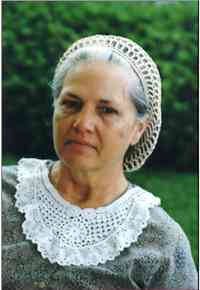 |
|
Marilyn
Dorl shares her great- grandmother Burton's diary relating life
during the Civil War
|
THE COURTHOUSE GROUNDS
even appeared
authentic as tents were set in place for the weekend of activities. In
one large tent was Larry and Marilyn Dorl and family from Grove,
Oklahoma. "I love it here," stated Marilyn as she
brewed morning coffee over an open fire. "My husband's
great-grandparents were in the War in the area so we feel very lucky to
be here. We have a copy of Great-grandmother Burton's diary that she
started in August of 1865. The excerpts were written in Midway,
Mississippi. In the diary she talks about riding the hand cart into
Bolton and Clinton and riding the train into Vicksburg."
"SURGEON
GENERAL"
read the sign on another large tent located on the courthouse front
lawn. This tent housed the Surgeon General, Leonard Woodrum of Panama
City, and his brigade. Major Jim Eller from Bristol, Tennessee, was one
of the men comprising the 2nd Brigade Medical Department.
 |
|
Col. Buddy "Bulldog" Eller and Major Jim Eller
of Bristol Tennessee (photo by Miller Dent)
|
Of special interest to
spectators milling around the tent was the unit's display of antique
medicine bottles and authentic Civil War surgical instruments. Just the
sight of the saw used for amputations was enough to make one cringe.
THE OLD MEDICAL
BOTTLES WERE FASCINATING. "We used to have a vast display of medicines and
old bottles that would have been used by the soldiers during the
war," commented Woodrum. "But, during a reenactment in
South Carolina, a big storm came up. The storm was so severe, the winds
took our tent and everything went up in the air including the bottles
and displays. 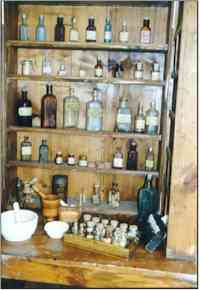 Most everything was broken as a result of the
storm. What you see in the case is about all that we have
left."
Most everything was broken as a result of the
storm. What you see in the case is about all that we have
left."
THE FRONTIER
MEDICAL BRIGADE tent was set up behind the Episcopal Church. "This
is a medical unit that represents the frontier brigade," stated
Herschel Stroud, Brigade Surgeon from Topeka, Kansas. "This
organization, based out of Salina, Kansas, encompasses troops from
Nebraska, Colorado, Oklahoma, Missouri and Kansas. What you see is the
typical field medical unit that would have been set up near the site of
a battle during the Civil War. The brigade worked like an emergency
treatment station. Initial care, including amputations, would have been
dispensed at sites like this. There were about 30,000 amputations
performed in the field during the Civil War."
DURING THE WEEKEND, all of the reenactors gave the
spectators a wonderful glimpse into Civil War times. While viewing the
camps, soldiers were seen cleaning their guns, playing cards or readying
themselves for battle. They lived off salt pork and hardtack. The women
were busy darning socks, fixing uniforms or preparing food. 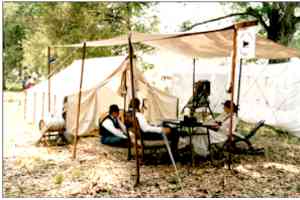 At
the sound of a bugle or drum, the troops would assemble and prepare for
battle.
At
the sound of a bugle or drum, the troops would assemble and prepare for
battle.
"THE TOWN OF
RAYMOND
and the people of Raymond are the most hospitable people that we've ever
met in the 10 years that we've been doing reenactments," stated
Major Jim Eller from Tennessee as he broke camp and prepared to leave
town. Everybody has gone overboard to make us feel welcome and to
take care of us. Our impression of everything was great. The reenactment
was something that brought tears to most of our eyes as we watched what
happened. I think this is one of the finer reenactments that we've been
to. So, we are real happy with the people of Raymond, the Town of
Raymond and the reenactors themselves."
Photographs by James and Rebecca Drake
| Home | Grant's
March | Pemberton's March | Battle
of Champion Hill | Order of Battle | Diaries & Accounts
| Official
Records |
| History
| Re-enactments | Book Store
| Battlefield Tour | Visitors |
Copyright (c) James and
Rebecca Drake, 1998 - 2002. All Rights Reserved. |